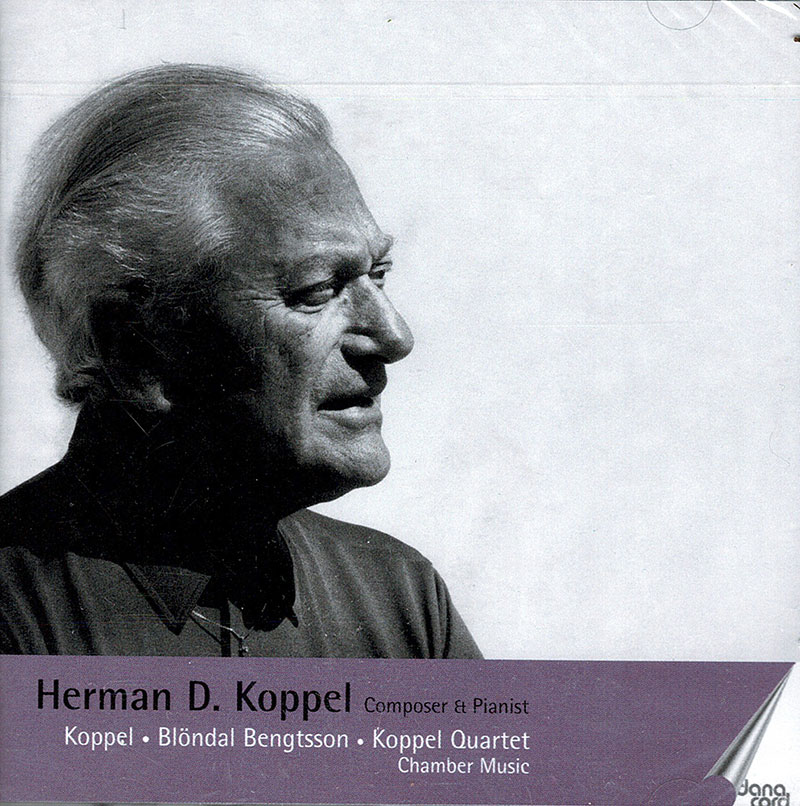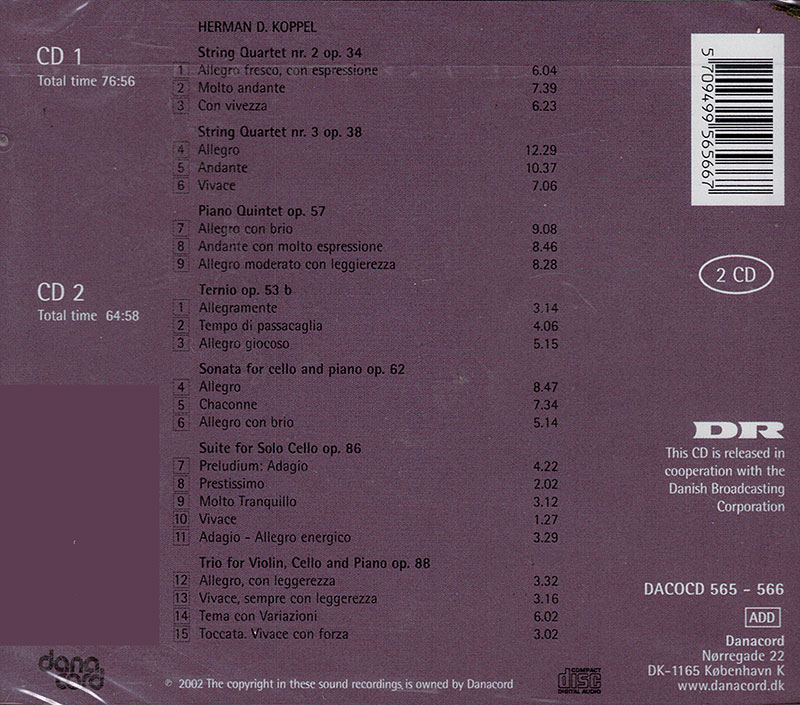Logowanie
Mikołaj - ten to ma gest!
Elton John, The Mamas & The Papas, Cat Stevens, Rod Stewart, Bobbie Gentry, Stevie Wonder, Engelbert Humperdinck
Memory Lane
Edycja Numerowana - 1000 egzemplarzy w skali światowej
RACHMANINOV, Eiji Oue, Minnesota Orchestra
Symphonic Dances / Vocalise
Best Recordings of 2001!!! NAJCZĘŚCIEJ KUPOWANA PŁYTA Z RR!
Karnawał czas zacząć!
Music of Love - Hi-Fi Latin Rhythms
Samba : Music of Celebration
AUDIOPHILE 24BIT RECORDING AND MASTERING
CHOPIN, LISZT, DEBUSSY, DVORAK, Gerhard Oppitz
Dances romantiques - A fantastic Notturno
Wzorcowa jakość audiofilska z Clearaudio
Winylowy niezbędnik
ClearAudio
Double Matrix Professional - Sonic
najbardziej inteligentna i skuteczna pralka do płyt winylowych wszelkiego typu - całkowicie automatyczna
Herman D. Koppel, Koppel Quartet
Chamber Musik

- Herman D. Koppel - composer, piano
- Koppel Quartet - quartet
String Quartet no 2 The first movement is a chain of mutually freely associating sections. Over pulsating chords the first violin unfolds a melodic line, starting with a syncopated ascending three-note figure, whose second interval, a 4th, is prominent throughout the movement. After an ascent the figure is turned downwards [0’18], the cello follows in canon, and the middle parts are put in motion as well. The melody culminates fortissimo two octaves higher than at the beginning, but then subsides. A new ascent [0’58] is completely dominated by the three-note figure and its inversion without getting so high up as before, and landing on the lowest notes of the cello. With a dancing accompaniment on open strings the 1st violin and the viola present a syncopated pizzicato-theme [1’41] which works itself into a fortissimo, once again ending on the lowest string of the cello. A cantabile recapitulation of the pizzicato-theme [2’13] leads into an expanding section where all instruments take turns in a melodic development. A sudden pianissimo [3’51] reminds us of the beginning of the movement, interrupted by a dramatic fortissimo foreshadowing the solemn second movement. The pizzicato-theme returns in a new disguise, and a short version of the first section of the movement makes a resolute end. The melancholy minor character of the viola theme beginning the slowly moving second movement, soon gives way to a more happy rendering in the 1st violin, and a little later [2’04] to a graceful interchange between the instruments. The happy mood is continued in a violin solo [3’18] while the lower instruments pick up the first theme. The dialogue continues between the instruments both in pairs and one at a time until they reach the climax of the movement. The initial theme returns [5’54] cantabile in the 1st violin and is brought to an end by the viola. The first part of the last movement is urged on by a hectic pulse in quintuple time with changing beat. A stubbornly repeated b is the outset for three melodic arches moving up through three octaves to a point [0’49] where a long cantabile violin melody in four beats overflows the quintuple marcato pulse, which in turn, with growing intensity, leads the section to a climax. In the middle section [2’09] the instruments accompany each other two by two in pleasant harmony through gently waving melodic lines, culminating after short chirping interpolations in a cheerful melody, whereupon [4’17] the marcato-pulse opens a summary of the agitated first part of the movement. String Quartet no. 3 A gentle waving theme is repeated in the 1st violin with the addition of increasingly profiled lower parts, ending up with a rapid, stubbornly repeated contrast figure in the cello, taken up by the viola with scattered chord interpolations from the other instruments. These two elements occur all through the movement in different versions: [1’27] a long melodic expansion of the theme over a continuation of the constantly moving contrast figure, and the figure as the impetus to [3’02] an energetic outlet which leads on to the rounding off of the first part of the movement after a short recollection of the theme and its second part. Even the melodic and rhythmic ornaments of the inserted episodes [2’37] are related to the theme and its lower parts. The middle section is polyphonic with the lower part of the theme as its starting point [3’46]. The contrast figure is cited briefly [5'39], and the polyphony is condensed into increasingly shorter melodic fragments and is finished off by the viola with three short attempts to the theme. Accompanied by pursuing rhythmic figures, the 2nd violin plays the lower part of the theme three times cantabile [6’26] whereupon the middle part dies out. It is followed by a compressed recapitulation [7’34], only half the length of the first part of the movement. The sad mood of the second movement with its dense sweet harmony is underlined by the muted sound. A rhythmically searching melody moves up three octaves, starts all over again espressivo, develops into a forte, dolce and dies away. The lively middle part is played without mutes; a spiral with a syncopated beginning moves from the viola to the violins and back again after a fortissimo where everybody fiddles away. As in the first movement the recapitulation is highly compressed. With an energetic cycling accompaniment as background, the last movement opens with a carefree melodic development with rhythmically staggered imitations. This game is interrupted [1’34] by a more quiet theme which begins as a descending melodic line, with pizzicato-accompaniment. The line is turned upside down [2’16] and is followed by a reminiscence of the opening melody played by the cello [2’39]. The quiet theme returns [3’05] in half tempo cantabile, reminding us of the beginning of the first movement. In the compressed recapitulation [4’41 the quiet theme emerges espressivo as the climax just before the final spurt.





























